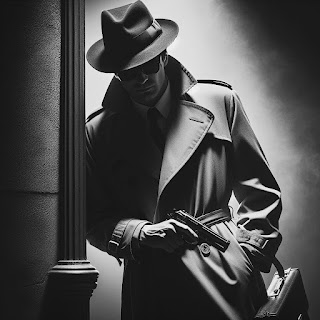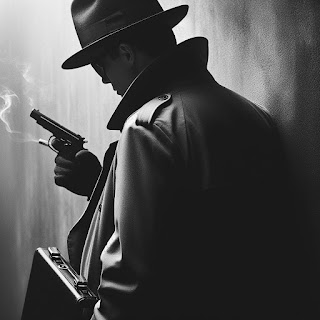WHEN SHOCKS MET YOCKS: THE GHOST AND MR. CHICKEN>
by Michael Mallory
A while back I wrote about the film that gets my vote for the worst ever made, an exercise in masochism titled Hillbillys in a Haunted House (1967). It’s a little-known “scare comedy” that’s about as scary as PAW Patrol and funny as Sophie’s Choice. But there is a film at the other end of the scale that is probably familiar to most, at least by title: The Ghost and Mr. Chicken. Released in 1966, it’s an old-style family-friendly comedy that has some genuinely creepy moments. It’s not a great movie, but it might be the perfect one to show the kids on Halloween as they’re working off their first sugar rush.
The Ghost and Mr. Chicken employs a time-honored formula: a murder mystery disguised as a horror film in which the creepy goings on are investigated by an endearing but hapless coward who, when push comes to shove, turns heroic and saves the girl. Bob Hope owed his early success in film to such a blueprint. While the concept already had whiskers by the time Mr. Chicken took a crack at it, it demonstrated that it was still possible to whip up a satisfying soufflé using old ingredients, if you knew how to mix them.
Produced on a modest budget by Universal Pictures, The Ghost and Mr. Chicken starred Don Knotts, who had recently left television’s The Andy Griffith Show. Griffith, in fact, was an uncredited story consultant on Mr. Chicken. Knotts plays Luther Heggs, the timid typesetter of a small-town Kansas newspaper who learns the background of a terrible murder that occurred in an old abandoned mansion in the town, which is reputedly haunted. He writes a filler piece about the crime that generates so much attention he is dared by the paper’s smug star reporter Ollie (Skip Homeier) to follow it up by spending the night inside the “murder house.” Luther does, and is literally scared unconscious by the horrifying sights and sounds.
Surviving the night, he publishes his experience in the paper and becomes the town celebrity overnight, even making headway with the woman he’s desperately in love with, who is also being courted by the overbearing Ollie. But then the heir of the man who built the house─ who supposedly murdered his wife and then took his own life─ shows up and, intent on razing the place, sues Luther and the paper for libel because of their coverage. Things don’t go well for Luther in court, so the judge decrees that the interested parties will visit the house themselves and decide whether Luther is lying or not. The visit takes place at night, and Luther leads the group to each location where an incident occurred…but nothing happens. After everyone has left, the dejected Luther once more hears the organ music and overcomes his fear to rush back in, and solves the secrets of the house, the ghost, and the murder.
Director Alan Rafkin and writers Jim Fritzell and Everett Greenbaum had all worked on The Andy Griffith Show, which meant they knew how to bring out the best in Don Knotts, and his best is what he delivered. The actor plays his awkward courting scenes with the object of his affection Alma (former Playboy playmate Joan Staley) with charm and warmth, but in the main set-piece of the film, the haunted house sleepover, Knotts trucks out every shaky, quaky, nervous man shtick he’d developed since his days on The Steve Allen Show. The sequence also provides jump scares galore and very creepy organ music played on a blood-spattered keyboard by an invisible organist. Composer Vic Mizzy’s eerie theme was reused in Curtis Harrington’s genuinely disturbing chiller Games the following year.
What distinguishes The Ghost and Mr. Chicken from other films of the time (particularly for Boomers who watched a lot of TV) is its cast. Dick Sargent (Bewitched’s second “Darren”), Liam Redmond, and Philip Ober round out the main cast but practically every supporting role, down to the bit parts, is filled by a Hollywood familiar face. The parade of old pros includes George Chandler, Charles Lane, Reta Shaw, Hal Smith, Ellen Corby, Dick “Mr. Whipple” Wilson, Lurene Tuttle, Hope Summers, Harry Hickox, Jesslyn Fax, Robert Cornthwaite, Sandra Gould, Nydia Westerman, James Millhollin, Phil Arnold, Al Checco, Herbie Faye, Florence Lake, Burt Mustin, Jim Boles, J. Edward McKinley, and Eddie Quillan. Those names might not ring any bells, but if you were to go online and look up their photos, a response of, “Oh, him!/her!” is all but assured.
Each seasoned actor makes the most of their moments on camera, be it a substantial role or a sight gag. True film buffs might even recognize the haunted house façade on the Universal backlot as the Dowd family’s Victorian edifice from the 1950 film Harvey (and not the Bates house from Psycho or the home of The Munsters).
There is a flaw connected to The Ghost and Mr. Chicken, but it’s not in the film itself, rather on the original poster which manages to tip off the identity of the culprit. But today’s audiences would have to seek out the poster, and there’s no reason to do so. Just enjoy the film, which after nearly sixty years is still a lot of fun.











3.JPG)








